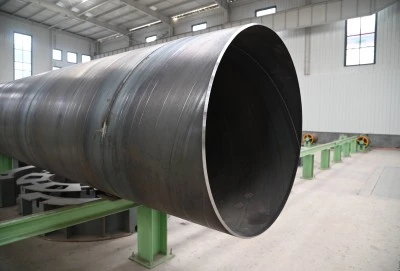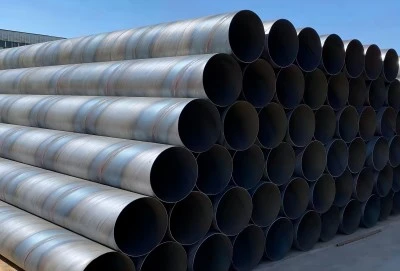Spiral welded pipe specification:
spiral welding pipe is crucial components in various industries, including oil and gas, water transportation, and construction. These pipes are manufactured by helically forming steel strips or plates into a tubular shape and then welding the seam. This unique production method allows for the creation of large-diameter pipes with excellent strength and versatility. Understanding the specifications of spiral welded pipes is essential for engineers, project managers, and procurement specialists to ensure they select the right product for their specific applications.
|
|
|
Dimensions:
The dimensions of spiral welding pipe are critical factors in determining their suitability for different projects. These pipes are available in a wide range of sizes to accommodate various industrial needs. According to ASTM A211 and other relevant standards, spiral welded pipes are manufactured in diverse dimensions to meet specific project requirements.
The key dimensional aspects of spiral welded pipes include the outer diameter, wall thickness, and length. These parameters are carefully controlled during the manufacturing process to ensure compliance with industry standards and customer specifications. The flexibility in dimensions allows for the production of pipes suitable for high-pressure applications, large-scale fluid transportation, and structural support in construction projects.
It's important to note that while standard dimensions are available, many manufacturers offer custom sizing options to meet unique project needs. This flexibility is one of the key advantages of spiral welded pipes, allowing for optimized designs in complex engineering projects.
Outer Diameter 8-120 2191mm--3048mm:
The outer diameter of spiral welding pipe typically ranges from 8 inches (219.1 mm) to 120 inches (3048 mm). This wide range of diameters makes spiral welded pipes suitable for various applications, from medium-sized pipelines to large-scale water transportation systems.
The production of pipes with such large diameters is one of the primary advantages of the spiral welding process. Traditional longitudinal welded pipes often have limitations in terms of maximum diameter due to manufacturing constraints. In contrast, spiral welding allows for the efficient production of pipes with diameters exceeding 100 inches, which are often required in major infrastructure projects.
Some common outer diameter ranges for spiral welded pipes include: - 8 inches to 24 inches (219.1 mm to 609.6 mm): Often used in oil and gas gathering systems and water distribution networks. - 30 inches to 60 inches (762 mm to 1524 mm): Frequently employed in main transmission pipelines and large-scale water projects. - 72 inches to 120 inches (1828.8 mm to 3048 mm): Utilized in major water transportation systems, hydroelectric projects, and as structural elements in construction.
The ability to produce pipes with such large diameters makes spiral welded pipes an essential choice for projects requiring high-volume fluid transportation or significant structural support.
Thickness SCH10-SCH160 635mm-5954mm:
The wall thickness of spiral welding pipe is another crucial specification that determines their pressure-bearing capacity and overall strength. The thickness is typically expressed in terms of schedule numbers, ranging from SCH10 to SCH160, corresponding to wall thicknesses from 6.35 mm to 59.54 mm.
The schedule number system, originally developed by the American National Standards Institute (ANSI), provides a standardized way to specify pipe wall thicknesses. Higher schedule numbers indicate thicker walls, which generally translate to higher pressure ratings and greater structural strength.
Some common thickness ranges and their typical applications include: - SCH10 to SCH40 (6.35 mm to 12.7 mm): Often used in low to medium-pressure applications, such as water distribution and some oil and gas gathering systems. - SCH60 to SCH80 (15.88 mm to 23.01 mm): Suitable for higher pressure applications, including oil and gas transmission pipelines. - SCH100 to SCH160 (30.96 mm to 59.54 mm): Used in high-pressure systems and applications requiring exceptional structural strength.
The selection of the appropriate wall thickness depends on factors such as the operating pressure, the type of fluid being transported, environmental conditions, and any additional structural requirements of the project. Engineers must carefully consider these factors when specifying the wall thickness of spiral welded pipes to ensure safe and efficient operation throughout the system's lifespan.
Length 6m-18m:
The length of spiral welding pipe is another important specification that affects transportation, installation, and overall project logistics. Typically, these pipes are manufactured in lengths ranging from 6 meters to 18 meters (approximately 20 feet to 59 feet).
The choice of pipe length is often influenced by several factors: 1. Transportation limitations: Longer pipes may require special transportation arrangements, which can impact project costs and timelines. 2. Installation requirements: The ease of handling and installation on-site may dictate the preferred pipe length. 3. Project specifications: Some projects may require specific pipe lengths to minimize the number of field welds or to fit within certain spatial constraints. 4. Manufacturing capabilities: Different manufacturers may have varying capacities for producing pipes of different lengths.
Common length options for spiral welded pipes include: - 6 meters (20 feet): Often used in projects where easier handling and transportation are priorities. - 12 meters (40 feet): A popular choice balancing ease of transportation with fewer field joints. - 18 meters (59 feet): Preferred in projects where minimizing field welds is crucial, despite the more challenging transportation requirements.
It's worth noting that some manufacturers can produce spiral welded pipes in custom lengths to meet specific project needs. This flexibility can be particularly beneficial in complex installations or when working within strict spatial constraints.
Spiral Welded Pipe Manufacturers:
When it comes to sourcing spiral welding pipe, selecting a reliable and experienced manufacturer is crucial. One such manufacturer is Longma, a company that has established itself as a trusted provider of high-quality spiral welded pipes for various industries.
Longma distinguishes itself in the market by offering customization options to tailor spiral welded pipes according to clients' specific requirements. This flexibility extends to key specifications such as diameter, wall thickness, and material grade. By providing customized solutions, Longma ensures that clients receive pipes that precisely meet their project needs, potentially optimizing performance and cost-effectiveness.
The company's ability to customize pipe specifications is particularly valuable in complex projects where standard off-the-shelf products may not suffice. This adaptability allows engineers and project managers to fine-tune their designs without being constrained by limited product options.
Longma's commitment to quality and customer satisfaction is evident in their approach to manufacturing. They employ advanced production techniques and rigorous quality control measures to ensure that their spiral welded pipes meet or exceed industry standards. This dedication to quality is crucial in applications where pipe integrity is paramount, such as in high-pressure oil and gas pipelines or critical water infrastructure projects.
For those in the process of selecting a spiral welded pipe manufacturer for their projects, Longma invites inquiries and consultations. Their team of experts can provide detailed information about their products, customization options, and how their pipes can meet the specific requirements of various applications. Interested parties can reach out to Longma at info@longma-group.com to discuss their project needs and explore potential solutions.














